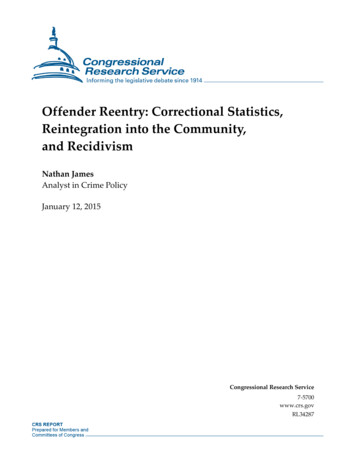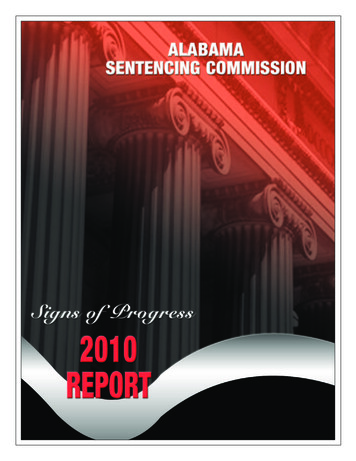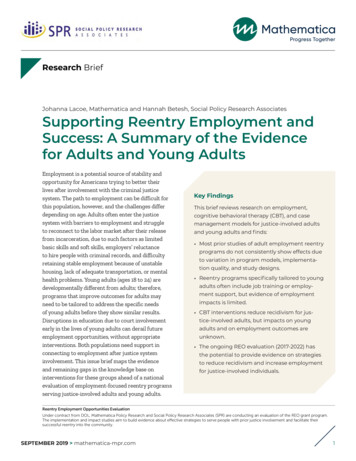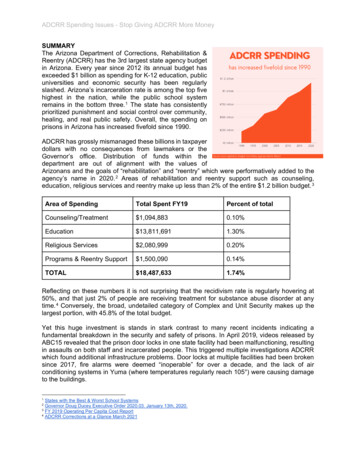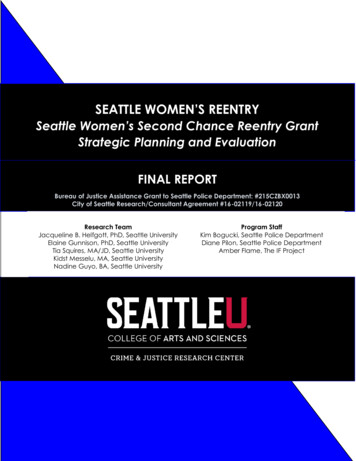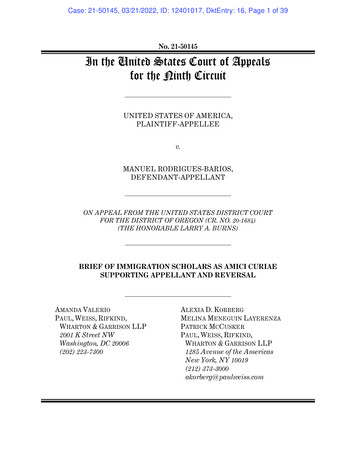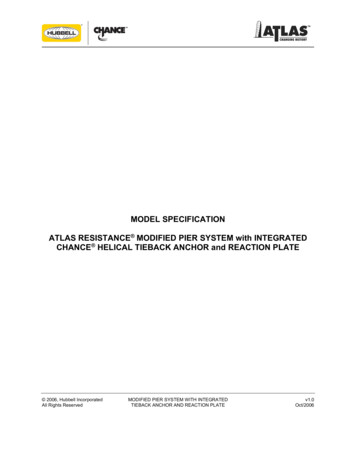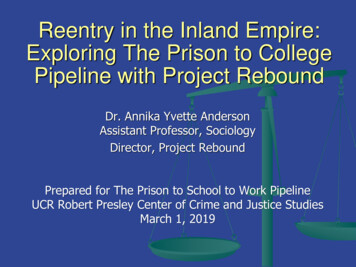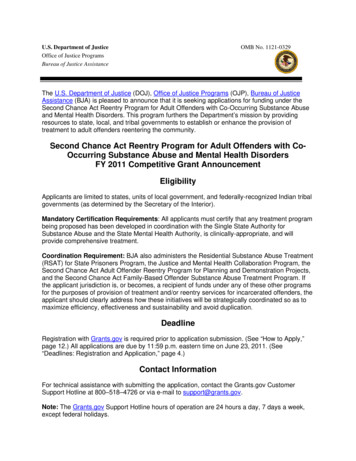
Transcription
U.S. Department of JusticeOffice of Justice ProgramsBureau of Justice AssistanceOMB No. 1121-0329The U.S. Department of Justice (DOJ), Office of Justice Programs (OJP), Bureau of JusticeAssistance (BJA) is pleased to announce that it is seeking applications for funding under theSecond Chance Act Reentry Program for Adult Offenders with Co-Occurring Substance Abuseand Mental Health Disorders. This program furthers the Department’s mission by providingresources to state, local, and tribal governments to establish or enhance the provision oftreatment to adult offenders reentering the community.Second Chance Act Reentry Program for Adult Offenders with CoOccurring Substance Abuse and Mental Health DisordersFY 2011 Competitive Grant AnnouncementEligibilityApplicants are limited to states, units of local government, and federally-recognized Indian tribalgovernments (as determined by the Secretary of the Interior).Mandatory Certification Requirements: All applicants must certify that any treatment programbeing proposed has been developed in coordination with the Single State Authority forSubstance Abuse and the State Mental Health Authority, is clinically-appropriate, and willprovide comprehensive treatment.Coordination Requirement: BJA also administers the Residential Substance Abuse Treatment(RSAT) for State Prisoners Program, the Justice and Mental Health Collaboration Program, theSecond Chance Act Adult Offender Reentry Program for Planning and Demonstration Projects,and the Second Chance Act Family-Based Offender Substance Abuse Treatment Program. Ifthe applicant jurisdiction is, or becomes, a recipient of funds under any of these other programsfor the purposes of provision of treatment and/or reentry services for incarcerated offenders, theapplicant should clearly address how these initiatives will be strategically coordinated so as tomaximize efficiency, effectiveness and sustainability and avoid duplication.DeadlineRegistration with Grants.gov is required prior to application submission. (See “How to Apply,”page 12.) All applications are due by 11:59 p.m. eastern time on June 23, 2011. (See“Deadlines: Registration and Application,” page 4.)Contact InformationFor technical assistance with submitting the application, contact the Grants.gov CustomerSupport Hotline at 800–518–4726 or via e-mail to support@grants.gov.Note: The Grants.gov Support Hotline hours of operation are 24 hours a day, 7 days a week,except federal holidays.
For assistance with any other requirement of this solicitation, contact the BJA JusticeInformation Center at 1–877–927–5657, via e-mail to JIC@telesishq.com, or by live web chat.The BJA Justice Information Center hours of operation are 8:30 a.m. to 5:00 p.m. eastern time,Monday through Friday, and 8:30 a.m. to 8:00 p.m. eastern time on the solicitation close date.Grants.gov number assigned to announcement: BJA-2011-3035Release date: May 12, 2011BJA-2011-3035OMB No. 1121-0329Approval Expires 02/28/20132
CONTENTSOverview4Deadlines: Registration and Application4Eligibility4Second Chance Act Reentry Program for Adult Offenders with Co-Occurring SubstanceAbuse and Mental Health Disorders—Specific Information4Performance Measures11Notice of New Post-Award Reporting Requirements12How to Apply12What an Application Should IncludeInformation to Complete the Application for Federal Assistance (SF-424)AbstractProgram NarrativeBudget Detail Worksheet and Budget NarrativeIndirect Cost Rate Agreement (if applicable)Tribal Authorizing Resolution (if applicable)Additional AttachmentsOther Standard Forms14Selection Criteria18Review Process19Additional Requirements20Application Checklist22Appendix 1: Fundamental Principles of Evidence-Based Correctional Practice23Appendix 2: Statement of Assurance26BJA-2011-3035OMB No. 1121-0329Approval Expires 02/28/20133
Second Chance Act Reentry Program for Adult Offenders with CoOccurring Substance Abuse and Mental Health Disorders(CFDA #16.812)OverviewThe Second Chance Act of 2007 (Pub. L. 110-199) provides a comprehensive response to theincreasing number of incarcerated adults and juveniles who are released from prison, jail, andjuvenile residential facilities and returning to communities. There are currently over 2.3 millionindividuals serving time in our federal and state prisons, and millions of people cycling throughlocal jails every year. Ninety-five percent of all offenders incarcerated today will eventually bereleased and will return to communities. The Second Chance Act helps to ensure that thetransition individuals make from prison, jail, or juvenile residential facilities to the community issuccessful and promotes public safety.Section 201 of the Second Chance Act authorizes federal awards to states, units of localgovernment, and Indian tribes to improve the provision of treatment to adult offenders in prisonsand jails during the period of incarceration and through the completion of parole or other courtsupervision after release into the community. The Bureau of Justice Statistics (BJS) reportedover 50 percent of jail and prison inmates were abusing or dependent on drugs in the yearbefore their admission to prison. BJS also has reported that 16 percent of jail and prisoninmates were identified as having a mental illness. Other studies have shown that prevalencerates of co-occurring substance abuse and mental health disorders in inmate populations arestriking. With regard to the prevalence of substance use disorders among those with severemental disorders, research indicates that jail detainees have a 72 percent rate of co-occurringsubstance use.Note: For those interested in submitting applications for specific juvenile-related reentryprojects, visit the Office of Juvenile Justice and Delinquency Prevention web site atwww.ojjdp.gov.Deadlines: Registration and ApplicationRegistration is required prior to submission. OJP strongly encourages registering withGrants.gov several weeks before the deadline for application submission. The deadline forapplying for funding under this announcement is 11:59 p.m. eastern time on June 23, 2011.Please see the “How to Apply” section, page 12 for more details. Please note that while thedeadline for submission is 11:59 p.m. eastern time on June 23, 2011, staff assistance throughthe BJA Justice Information Center is only available until 8:00 p.m. eastern time (see “ContactInformation” on the title page for more information about BJA’s Justice Information Center).EligibilityPlease refer to the title page for eligibility under this program.BJA-2011-3035OMB No. 1121-0329Approval Expires 02/28/20134
Second Chance Act Reentry Program for Adult Offenders with CoOccurring Substance Abuse and Mental Health Disorders—SpecificInformationBJA recognizes that a significant number of individuals who are incarcerated and returning tothe community have chronic substance abuse and mental health disorders and are in need oftreatment in order to successfully complete their supervision, reduce recidivism, and promotepublic safety. The coordination of drug abuse and mental health treatment with correctionalplanning can encourage participation in treatment and can help treatment providers incorporatecorrectional requirements as treatment goals.Research from the National Institute on Drug Abuse indicates that those who complete prisonbased treatment and continue with treatment in the community have the best outcomes. Inaddition, evidence indicates that medications are an important part of treatment for many drugabusing offenders and should be made available as part of substance abuse treatment whenappropriate. Outcomes for drug abusing offenders can be improved by monitoring drug use andby encouraging continued participation in treatment. Ongoing coordination between treatmentproviders and community corrections is important in addressing the complex needs of these reentering individuals.Goals and ObjectivesThe goal of Section 201 of the Second Chance Act is to provide support to eligible applicants forthe development and implementation of comprehensive and collaborative strategies thataddress the challenges posed by reentry to increase public safety and reduce recidivism. Theobjectives of this program are to provide offenders with co-occurring substance abuse andmental health disorders with appropriate evidence-based services—including addressingindividual criminogenic needs—based on a reentry plan that relies on a risk and needsassessment that reflects the risk of recidivism for that offender. Funds may be used for treatingco-occurring substance abuse and mental health disorders in prison programs and jails,providing recovery support services, reentry planning and programming, and post-releasetreatment and aftercare programming in the community through the completion of parole orcourt supervision.BJA also administers the Residential Substance Abuse Treatment (RSAT) for State PrisonersProgram, the Justice and Mental Health Collaboration Program, the Second Chance Act AdultOffender Reentry Program for Planning and Demonstration Projects, and the Second ChanceAct Family-Based Offender Substance Abuse Treatment Program. If the applicant jurisdiction is,or becomes, a recipient of funds under any of these other programs for the purposes ofprovision of treatment and/or reentry services for incarcerated offenders, the applicant shouldclearly address how these initiatives will be strategically coordinated so as to maximizeefficiency, effectiveness and sustainability and avoid duplication. More information on each ofthese programs can be found at www.bja.gov.Approved Uses of Award FundsFundamental principles of evidence-based correctional practice. The primary objective of theSecond Chance Act is to reduce recidivism. Based upon reliable research findings, there are sixfundamental principles of evidence-based correctional practice that are widely accepted asBJA-2011-3035OMB No. 1121-0329Approval Expires 02/28/20135
strategies to reduce future criminal behavior. Applicants are required to clearly articulate howthe following six principles are integrated into their program design:1. Objectively Assess Criminogenic Risks and Needs2. Enhance Intrinsic Motivation3. Target Higher-Risk Offenders4. Address Offenders’ Greatest Criminogenic Needs5. Use Cognitive-Behavioral Interventions6. Determine Dosage and Intensity of ServicesAppendix 1 provides additional information about these six principles and what applicantsshould consider to ensure proposed programs are built on principles of effective practice.Program design elements. Applicants should also address the following program designelements in the proposal:1. Use of Actuarial-Based Assessment Instruments for Treatment and Reentry Planning:Applicants are strongly urged to use screening instruments and assessment processes thatare reliable, validated, and normed for their specific target population in order to increasethe chances that individuals will be matched with the appropriate type of treatment andreentry services.2. Targeting of Criminogenic Needs that Affect Recidivism: While offenders reentering thecommunity have a variety of treatment and behavioral needs, which are themselves riskfactors for future offending, criminogenic needs are the dynamic risk factors most closelyassociated with offending behavior. Criminogenic risk and needs factors include history ofanti-social behavior; anti-social personality pattern; anti-social cognition; anti-socialassociates; family and/or marital status; school and/or work; leisure and/or recreation; andsubstance abuse. Applicants are strongly urged to provide cognitive-based treatmentinterventions that target criminal thinking, especially for higher-risk offenders.3. Provision of Evidence-Based Substance Abuse and Mental Health TreatmentServices: Applicants are strongly urged to provide substance abuse and mental healthtreatment practices and services that have a demonstrated evidence base and that areappropriate for the target population. 1 Applicants should identify the evidence-basedpractice being proposed for implementation, identify and discuss the evidence that shows1Applicants can also find information on evidence-based practices in the Substance Abuse and Mental HealthServices Administration’s (SAMHSA) Guide to Evidence-Based Practices available atwww.samhsa.gov/ebpwebguide. The Guide provides a short description and a link to dozens of web sites withrelevant evidence-based practices information – either specific interventions or comprehensive reviews of researchfindings. Please note that SAMHSA’s Guide to Evidence-Based Practices also references the National Registry ofEvidence-Based Programs and Practices (NREPP), a searchable database of interventions for the prevention andtreatment of mental and substance use disorders. NREPP is intended to serve as a decision support tool, not as anauthoritative list of effective interventions. Being included in NREPP, or in any other resource listed in the Guide,does not mean an intervention is “recommended” or that it has been demonstrated to achieve positive results in allcircumstances. Applicants must document that the selected practice is appropriate for the specific target populationand purposes of your project.BJA-2011-3035OMB No. 1121-0329Approval Expires 02/28/20136
that the practice is effective; and discuss the population(s) for which this practice has beenshown to be effective and show that it is appropriate for the proposed target population.Applicants are strongly urged to provide integrated treatment of co-occurring disorders,including a consistent message to program participants about substance use and mentalhealth treatment, and integrated clinical treatment provided by treatment specialists withknowledge of both substance use disorders and serious mental illnesses and anunderstanding of the complexity of interactions between disorders. Applicants areencouraged to design treatment programs that provide individualized programming thataddresses participants’ psychosocial problems and skills deficiencies, created throughcomprehensive assessment and consultation with the treatment participant and provider.Applicants must indicate how treatment will begin prior to release and be continuedafter participating offenders are released into the community.Proposed programs should require urinalysis and/or other proven reliable forms of drug andalcohol testing for program participants, including both periodic and random testing, and forformer participants while they remain in the custody, or under community supervision, of thestate, local, or tribal government.Prison-based programs must provide residential treatment facilities set apart—in acompletely separate facility or dedicated housing unit in a facility exclusively for use byparticipants—from the general correctional population. Offenders included in prison-basedprograms must be within 6–12 months before scheduled release to the community.Applicants must indicate how dual diagnosis treatment will be continued after participatingoffenders are release into the community.4. Pharmacological Drug Treatment Services: Applicants are encouraged to utilizepharmacological drug treatment services as part of any drug treatment program offered tooffenders in prison or jail.5. Transition Planning Procedures: Developing and implementing transition planningprocedures to ensure linkages to services and benefits is a critical part of the reentryprocess. Applicants should consider institutionalizing appropriate information sharing withrelevant community corrections and behavioral health partner agencies, assessinginsurance and benefit status (including Medicaid, SSI, SSDI, veterans benefits, and othergovernment entitlement programs) and eligibility, and assisting inmates in theinsurance/benefits application process.6. Support of a Comprehensive Range of Recovery Support Services: Applicants areencouraged to make available a comprehensive range of programs, including services thatemploy the cognitive, behavioral, and social learning techniques of modeling, role playing,reinforcement, resource provision, and cognitive restructuring; educational, literacy,vocational, and job placement services, including supported employment; ongoingevidenced-based substance abuse (including alcohol abuse); and mental health disordertreatment; housing, physical health care services; veteran-specific services as applicable;programs that encourage safe, healthy, and responsible family and parent-childrelationships and enhance family reunification, as appropriate; and, mentoring.7. Provision of Sustained Aftercare, Case Planning/Management in the Community:Applicants are strongly urged to use consistent pre- and post-release case managementBJA-2011-3035OMB No. 1121-0329Approval Expires 02/28/20137
and supervision that is sustained over a period of at least 6 months from the time of release,or through the completion of parole or court supervision, whichever is shorter, and isespecially responsive to the offender’s transition from incarceration to the community.Aftercare services must involve coordination between the correctional treatment program,community supervision program, and other social service and rehabilitation programs, suchas education and job training, parole supervision, halfway houses, self-help, and peer groupprograms. Post-release treatment and aftercare must be coordinated, including informationsharing, and in-reach allowed for community-based treatment providers.8. Provision of Community Supervision Services which Follow Evidence-BasedPractices:Funds may be used to provide evidence-based community supervision services includingthe development and supervision of individualized case plans which stem from risk andneeds assessments; the use of graduated responses including the employment ofstructured, swift, and incremental responses to violations; structuring supervision caseloadswhich reflect the level of risk and needs for the target population; and staff developmentincluding training in effective offender management techniques.Applicants are encouraged to consider a partnership with a local research organization that canassist with data collection, performance measurement, and local evaluations. One resource thatapplicants may be interested in using is the e-Consortium for University Centers andResearchers for Partnership with Justice Practitioners. The purpose of this e-Consortium is toprovide a resource to local, state, federal, and other groups who seek to connect to nearby (orother) university researchers and centers on partnerships and projects that are mutuallybeneficial to the criminal justice community. The e-Consortium can be found online atwww.gmuconsortium.org/.Priority ConsiderationsPriority consideration will be given to applicants that consider the following in the developmentof their program: Target medium- to high-risk offenders, as identified through use of a validated risk andneeds assessment instrument, who have been dually diagnosed with serious mental healthdisorders and substance abuse addictions.Target female offenders.Focus their program on geographic areas with high rates of offenders returning from prisonsor jails.Jurisdictions implementing specialized probation services for the target population, asdescribed in The Consensus Project’s Improving Responses to People with MentalIllnesses: The Essential Elements of Specialized Probation Initiatives.Jurisdictions proposing to partner with a research organization to conduct a rigorous localevaluation of their strategies (including community corrections supervision approaches) willalso receive priority consideration.Definitions Recidivism: The Second Chance Act requires that recidivism be a measure of success infunded programs. For purposes of this solicitation, recidivism is defined as “a return toBJA-2011-3035OMB No. 1121-0329Approval Expires 02/28/20138
prison and/or jail with either a new conviction or as the result of a violation of the terms ofsupervision within 12 months of initial release.”Prison-Based Programs: Prison-Based programs are in prison or “behind the walls”programs that must provide residential treatment facilities set apart—in a completelyseparate facility or dedicated housing unit in a facility exclusively for use by participants—from the general correctional population. Offenders included in prison-based programs mustbe within 6–12 months before scheduled release to the community.Co-occurring Disorders (COD): Co-occurring disorders (COD) refers to co-occurringsubstance-related and mental disorders. Clients said to have COD have one or moresubstance-related disorders as well as one or more mental disorders. At the individual level,COD exist “when at least one disorder of each type can be established independent of theother and is not simply a cluster of symptoms resulting from [a single] disorder.”Evidence-Based Programs or Practices (EBP): OJP considers programs and practices tobe evidence-based when their effectiveness has been demonstrated by causal evidence(generally obtained through one or more outcome evaluations). Causal evidence documentsa relationship between an activity or intervention (including technology) and its intendedoutcome, including measuring the direction and size of a change, and the extent to which achange may be attributed to the activity or intervention. Causal evidence depends on theuse of scientific methods to rule out, to the extent possible, alternative explanations for thedocumented change. The strength of causal evidence, based on the factors describedabove, will influence the degree to which OJP considers a program or practice to beevidence-based.Amount and Length of AwardsAwards will be for a period of 24 months. Contingent upon the availability of funds and thenumber of adult offenders projected to be served, awards of up to 600,000 each are expectedto be made.All awards are subject to the availability of appropriated funds and any modifications oradditional requirements that may be imposed by law.Budget InformationLimitation on Use of Award Funds for Employee Compensation; Waiver: With respect toany award of more than 250,000 made under this solicitation, federal funds may not be used topay total cash compensation (salary plus bonuses) to any employee of the award recipient at arate that exceeds 110 percent of the maximum annual salary payable to a member of theFederal Government’s Senior Executive Service (SES) at an agency with a Certified SESPerformance Appraisal System for that year. (The 2011 salary table for SES employees isavailable at www.opm.gov/oca/11tables/indexSES.asp.) Note: A recipient may compensate anemployee at a higher rate, provided the amount in excess of this compensation limitation is paidwith non-federal funds. (Any such additional compensation will not be considered matchingfunds where match requirements apply.)The limitation on compensation rates allowable under an award may be waived on an individualbasis at the discretion of the Assistant Attorney General (AAG) for OJP. An applicant thatwishes to request a waiver must include a detailed justification in the budget narrative of itsapplication. Unless the applicant submits a waiver request and justification with the application,BJA-2011-3035OMB No. 1121-0329Approval Expires 02/28/20139
the applicant should anticipate that OJP will request the applicant to adjust and resubmit itsbudget.The justification should include: the particular qualifications and expertise of the individual, theuniqueness of the service being provided, the individual’s specific knowledge of the program orproject being undertaken with award funds, and a statement explaining that the individual’ssalary is commensurate with the regular and customary rate for an individual with his/herqualifications and expertise, and for the work that is to be done.Match Requirement: There is no match requirement for this solicitation.Performance MeasuresTo assist in fulfilling the Department’s responsibilities under the Government Performance andResults Act (GPRA), Public Law 103-62, applicants that receive funding under this solicitationmust provide data that measure the results of their work. Any award recipient will be required,post award, to provide the data requested in the “Data Grantee Provides” column so that OJPcan calculate values for the “Performance Measures” column. Performance measures for thisprogram are being finalized. Below, BJA has listed the program objectives and sampleperformance measures. BJA will determine whether additional or different measures willbe required prior to awarding grants.Program GoalPerformance MeasuresData Grantee ProvidesIncrease public safetyand reduce recidivismthrough activitiestargeted to addresscriminal behaviorimpacted by co-occurringsubstance abuse andmental health disorders.Percent decrease inrecidivism rates. Percent reduction in the crimerate.Percent increase in programparticipants who areemployed.Percent increase in numberof participants enrolled ineducational programs.Number of participants added to the programduring the current reporting period. Number of participants in the program at thebeginning of the reporting period. Number of participants in the program at the endof the reporting period Number of participants released from jail orprison during the current reporting period. Number of participants released from jail orprison since the beginning of the program (autocalculated by PMT). Number of participants sentenced to prison witha new conviction this reporting period. Number of participants sentenced to prison witha new conviction since the beginning of theprogram (auto-calculated by PMT). Number of crimes reported during this quarter. Population for the area that the TP is returning to(i.e., statewide, county, city, neighborhood).**Requested to produce a crime rate. Number of participants who found employmentduring this reporting period. Number of participants employed at thebeginning of the reporting period. Number of participants employed at the end ofthe reporting period. Number of participants provided withemployment services Number of participants who enrolled in aneducational program during this reporting period. Number of participants enrolled in anBJA-2011-3035OMB No. 1121-0329Approval Expires 02/28/201310
Percent reduction in thenumber of participants whoviolated conditions ofsupervised release. Percent increase in thenumber of participants whofulfilled their child supportobligations.Percent increase in thenumber of participants whoobtained housing. Percent increase in thenumber of participantsassessed as needingsubstance abuse healthservices who participated inthose services. Percent increase in thenumber of participantsassessed as needing mentalhealth services whoparticipated in those services. educational program at the beginning of thereporting period.Number of participants enrolled in aneducational program at the end of the reportingperiod.Number of participants who violated theconditions of their supervised release during thisreporting period.Number of participants who have violated theconditions of their supervised release since thebeginning of this program (auto-calculated byPMT).Number of participants who were required to paychild support this reporting period.Number of participants who paid their childsupport this reporting period.Number of participants who obtained housingthis reporting period.Number of participants who have found housingsince the beginning of this program (autocalculated by PMT).Number of participants who were provided withhousing services during this reporting period.Number of participants who were assessed asneeding substance abuse services during thisreporting period.Number of participants who have been assessedas needing substance abuse services since thebeginning of this program (auto-calculated byPMT).Number of participants who enrolled in asubstance abuse program during this reportingperiod.Number of participants enrolled in a substanceabuse program since the beginning of thisprogram (auto-calculated by PMT).Number of participants who were assessed asneeding mental health services during thisreporting period.Number of participants who have been assessedas needing mental health services since thebeginning of this program (auto-calculated byPMT).Number of participants who enrolled in a mentalhealth program during this reporting period.Number of participants enrolled in a mentalhealth program since the beginning of thisprogram (auto-calculated by PMT).Percent of participants whocompleted the residentialprogram and have passeddrug testing. Total number of offenders that testedpositive for drug use during this reportingperiod.)Total number of offenders that were drugtested during this reporting period.)Percent reduction in alcoholabuse and consumption. Total number of offenders who tested positivefor alcohol during the reporting period.Total number of offenders who were tested foralcohol during this reporting period. BJA-2011-3035OMB No. 1121-0329Approval Expires 02/28/201311
Submission of performance measures data is not required for the application. Instead,applicants should discuss in their application their proposed methods for collecting data forperformance measures. Please refer to the section “What an Application Should Include”(below) for additional information.Note on Project Evaluations: Applicants that propose to use funds awarded through thissolicitation to conduct project evaluations should be aware that certain project evaluations (suchas systematic investigations designed to develop or contribute to generalizable knowledge) mayconstitute “research” for purposes of applicable DOJ human subjects protection. However,project evaluations that are intended only to generate internal improvements to a program orservice, or are conducted only to meet OJP’s performa
Goals and Objectives . . Act Family-Based Offender Substance Abuse Treatment Program. If the applicant jurisdiction is, or becomes, a recipient of funds under any of these other programs for the purposes of provision of treatment and/or reentry services for incarcerated offenders, the applicant should .
